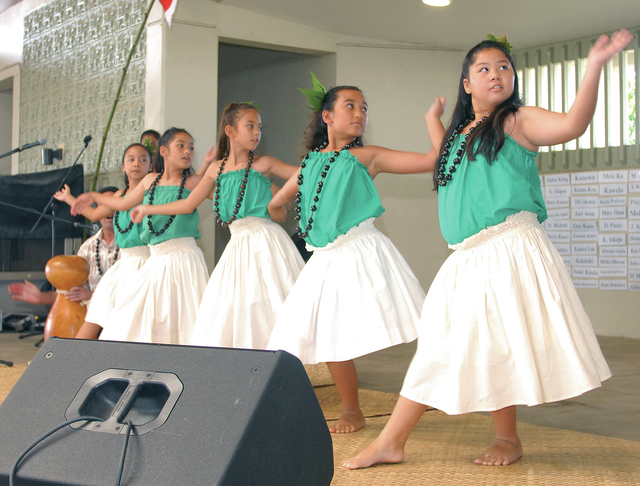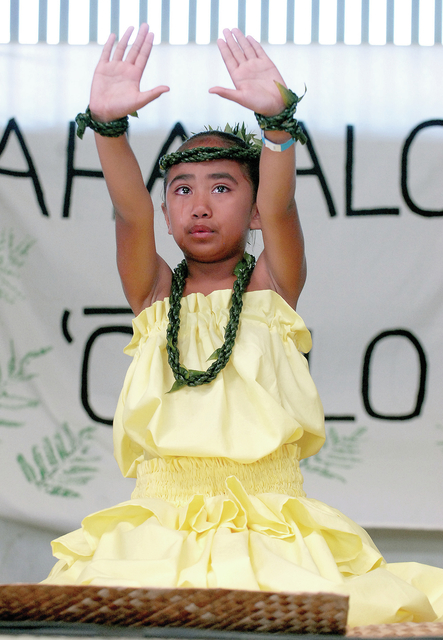KAILUA-KONA—Standing in front of a crowd of hundreds and greeting them with a loud “Aloha!” Koa Manwarring launched into his mo’oku’auhau, his genealogical chant, reciting his ancestors back to his great-great grandparents.
KAILUA-KONA—Standing in front of a crowd of hundreds and greeting them with a loud “Aloha!” Koa Manwarring launched into his mo’oku’auhau, his genealogical chant, reciting his ancestors back to his great-great grandparents.
Learning Hawaiian can be hard for the 5-year-old, he said, but he practices every day at home and his school, Ke Kula ‘O ‘Ehunuikaimalino in Kealakekua.
Saturday was his chance to put his knowledge to the test at the fourth annual ‘Aha Aloha ‘Olelo held at Maka’eo, the Old Airport Pavilion. The annual event featured speaking, memorized presentations, singing as well as chant and hula, all in the Hawaiian language. It benefited Punana Leo O Kona.
“In order to know who you are and where you’re going, you need to know where you are from,” said Koa’s mother, Tara Manwarring, “and so the genealogy chant reinforces that for us.”
It was the first time Manwarring said they’ve attended an event like the ‘Aha Aloha ‘Olelo.
Manwarring said that as a Hawaiian family, it’s important for them to participate in the preservation and perpetuation of the language.
“I speak a little bit,” she said. “As he goes through school and learns, I’m learning as well.”
Having her son learning the language has pushed her to do her own research so she can help him with schoolwork. Creating that connection and learning along with her son, she said, “is such a cool experience.”
“I tell other parents that it is such an important part of our lives if they want to continue the language and Hawaiian culture,” she said.
Hawaiian could be heard throughout the pavilion on Saturday from the speeches and presentations on stage to the conversation among those working the event.
All of it, said organizer Kaho’okahi Kanuha, was for a specific purpose.
“We need to become more used to hearing it,” he said of the Hawaiian language. “It shouldn’t be something we’re surprised to hear.”
Kanuha wants the language to be normalized, something that’s spoken everywhere and not just heard inside a classroom. Residents of the islands, he said, have a responsibility to the language of this place.
Revitalizing the language, Kanuha said, starts with the younger generation.
Parents, he said, can sometimes be apprehensive about putting their kids into immersion programs, but that changes once kids start getting a grasp on the language, he said.
“When they see their kids come home within weeks, and within months with the ability to speak and understand Hawaiian, it ignites something within them,” he said. “And they have this awakening, this remembering that this is their language and that they have a responsibility along with their children to perpetuate it.”
And parents, he added, have an important responsibility to their children to empower their Hawaiian education.
“In order for us to truly normalize Hawaiian, not only in the community but within one’s self, it has to be perpetuated and continued by the family,” he said. “There has to be a bridge built between the school and the home; you can’t have the child or the student living in two different worlds.”
That’s an idea hula instructor Kekoa Harman can get behind. Many of his students were performing at the competition.
Harman, who with his wife are the kumu of Halau I Ka Leo Ola O Na Mamo, said it’s important for the language to be spoken generationally.
“It can’t just live in the school environment,” said Harman.
For that reason, he said, he wants to see the language thrive outside of academia.
“I would like to see it as many places as it can go,” said Harman. “I don’t want to place any limits on where it can go.”
Kanuha too said there are opportunities to increase the use of Hawaiian, noting especially that it’s been one of the state’s two official languages since 1978.
“I’d like to see it everywhere,” he said, saying it can be implemented everywhere from schools to traffic signs to stores. “I’d like to see Hawaiian everywhere I see English.”
And there are small things too people can do to keep the language alive.
“We shouldn’t be saying ‘Hi’ and ‘Bye,’” he said. “We should be saying ‘Aloha’ and ‘A hui hou.’ We should say ‘Mahalo.’”
Little things like that, he said, go a long way for normalizing the language in the public space. People notice its use, he said, which reinforce Hawaiian as a living language.
“So we can start there,” he added. “Whatever we know, whatever ability we have in the Hawaiian language, utilize it, normalize it in a way that’s inclusive and not exclusive.”
Speaking Hawaiian, he added, is also a political act.
“I think speaking Hawaiian is an act of resistance,” he said pointing to the theme of the event, which was an 1897 speech given by James Keauiluna Kaulia, who was at the time president of Hui Aloha ‘Aina, or the Hawaiian Patriotic League, when the U.S. government was considering the issue of annexing Hawaii.
“I don’t believe you can separate Hawaiian, the language, from the politics or from the culture,” he added.
Youth who performed at the contest said they enjoyed the opportunity to keep Hawaiian cultural traditions alive. That included Kalehua Soller.
“I love the feeling of it,” she said, adding that there’s “meaning behind every song I do.”
The 15-year-old is a student at Ke Kula ‘O Nawahiokalani’opu’u in Kea’au.
Every song and chant she does is different, she said, which is something she loves about it.
“You don’t see hulas that are exactly alike,” she said.
On Saturday, Soller’s hula was A Ka La’i au i Hanakahi, which she explained is about Ruth Ke’elikolani.
The girl said she admired Ke’elikolani’s commitment to preserving Hawaii’s language and culture and considers her a role model.
Soller also encourages other youth to learn hula and the language, saying it “brings out the inner Hawaiian in them.”
“It’s very, very important to our people,” she said. “I tell most of the kids to do hula so they know the story of our ancestors.”


